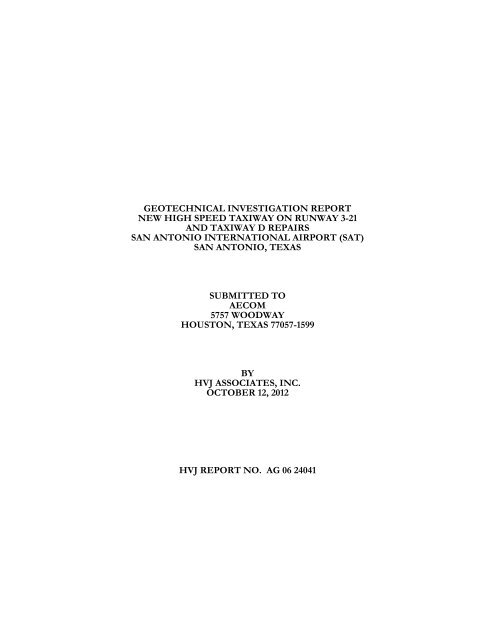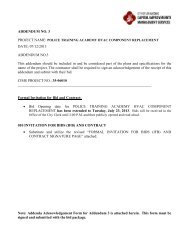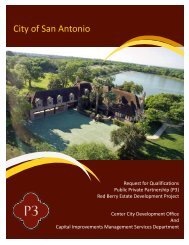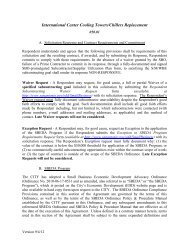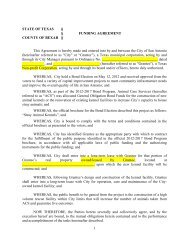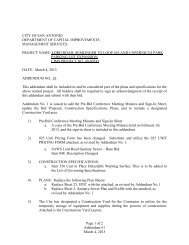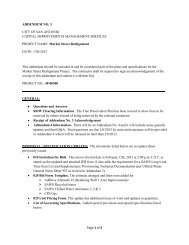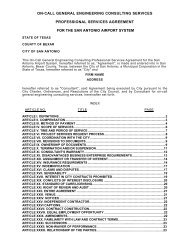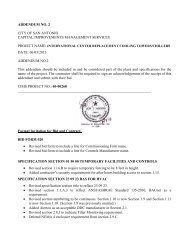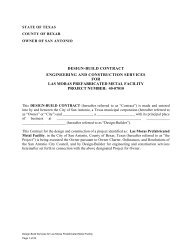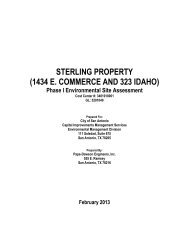Geotechnical Investigation Report - The City of San Antonio
Geotechnical Investigation Report - The City of San Antonio
Geotechnical Investigation Report - The City of San Antonio
- No tags were found...
Create successful ePaper yourself
Turn your PDF publications into a flip-book with our unique Google optimized e-Paper software.
GEOTECHNICAL INVESTIGATION REPORT<br />
NEW HIGH SPEED TAXIWAY ON RUNWAY 3-21<br />
AND TAXIWAY D REPAIRS<br />
SAN ANTONIO INTERNATIONAL AIRPORT (SAT)<br />
SAN ANTONIO, TEXAS<br />
SUBMITTED TO<br />
AECOM<br />
5757 WOODWAY<br />
HOUSTON, TEXAS 77057-1599<br />
BY<br />
HVJ ASSOCIATES, INC.<br />
OCTOBER 12, 2012<br />
HVJ REPORT NO. AG 06 24041
October 12, 2012<br />
Mr. Guo-Pin Fuan, P.E.<br />
AECOM<br />
5757 Woodway<br />
Houston, TX 77057-1599<br />
Re:<br />
New High Speed Taxiway on Runway 3-21 and Taxiway D Repairs<br />
Owner: <strong>City</strong> <strong>of</strong> <strong>San</strong> <strong>Antonio</strong>, Texas (COSA), <strong>San</strong> <strong>Antonio</strong> International Airport (SAT)<br />
HVJ Project No: AG0624041<br />
Dear Guo-Pin:<br />
Submitted herein is the geotechnical data report <strong>of</strong> our geotechnical investigation for the above<br />
referenced project. <strong>The</strong> study was performed in accordance with HVJ proposal number AG0624041<br />
dated October 24, 2011 (Revised November 29, 2011 and February 6, 2012).<br />
It has been a pleasure to work for you on this project and we appreciate the opportunity to be <strong>of</strong><br />
service. Please notify us if there are questions or if we may be <strong>of</strong> further assistance.<br />
Sincerely,<br />
HVJ ASSOCIATES, INC.<br />
Texas Firm Registration No. F-000646<br />
Jason Schwarz, P.E.<br />
Project Manager<br />
10-12-12<br />
<strong>The</strong> seal appearing on this document was authorized by Jason Schwarz, PE 99343 on October 12, 2012. Alteration <strong>of</strong> a<br />
sealed document without proper notification to the responsible engineer is an <strong>of</strong>fense under the Texas Engineering<br />
Practice Act.
TABLE OF CONTENTS<br />
I. EXECUTIVE SUMMARY ..................................................................................................................... I<br />
1 INTRODUCTION ................................................................................................................................... 1<br />
1.1 General ............................................................................................................................................ 1<br />
1.2 Scope <strong>of</strong> Work ............................................................................................................................... 1<br />
2 FIELD EXPLORATION ......................................................................................................................... 1<br />
2.1 General ............................................................................................................................................ 1<br />
2.2 Sampling Methods and Field Testing ................................................................................... 1<br />
2.3 Borehole Completion .................................................................................................................. 2<br />
3 LABORATORY TESTING ................................................................................................................... 2<br />
4 SITE CHARACTERIZATION ............................................................................................................. 3<br />
4.1 General Geology ........................................................................................................................... 3<br />
4.2 Subsurface Stratigraphy ............................................................................................................. 3<br />
4.3 Groundwater .................................................................................................................................. 5<br />
5 LIMITATIONS ......................................................................................................................................... 5<br />
Page
ILLUSTRATIONS<br />
PLATE<br />
SITE VICINITY MAP ..................................................................................................................................... 1<br />
GEOLOGY MAP ............................................................................................................................................. 2<br />
PLAN OF BORINGS ...................................................................................................................................... 3<br />
BORING LOGS ......................................................................................................................................... 4 - 7<br />
KEY TO SYMBOLS .......................................................................................................................... 8A & 8B<br />
APPENDICES<br />
APPENDIX<br />
LABORATORY TEST RESULTS SUMMARY ........................................................................................ A
I. EXECUTIVE SUMMARY<br />
HVJ Associates, Inc. (HVJ) was retained by AECOM to perform a geotechnical investigation for the<br />
proposed new High Speed Taxiway on Runway 3-21 as well as proposed repairs to existing Taxiway<br />
D at the <strong>San</strong> <strong>Antonio</strong> International Airport, located just north <strong>of</strong> Loop 410 and east <strong>of</strong> US Highway<br />
281, in <strong>San</strong> <strong>Antonio</strong>, TX.<br />
A brief summary <strong>of</strong> the investigational findings and pertinent recommendations is as follows:<br />
1. Four (4) borings, designated as B-5 through B-8, were drilled with truck-mounted equipment<br />
using dry auger and sampling techniques, at designated locations, to termination depths<br />
between approximately eight (8) ten and (10) feet below grade. <strong>The</strong> concrete on Taxiway D<br />
was cored using a portable coring rig.<br />
2. <strong>The</strong> existing concrete thickness on Taxiway D ranged between approximately fourteen (14)<br />
and nineteen (19) inches and was underlain by twelve (12) to sixteen (16) inches <strong>of</strong> cement<br />
treated base. Table 1 provides data for the pavement and base/fill thicknesses.<br />
Table 1 – Concrete and Base Thickness<br />
Boring No.<br />
Concrete<br />
Thickness<br />
(inches)<br />
Approximate<br />
Base Thickness<br />
(inches)<br />
B-7 19 12<br />
B-8 14 16<br />
3. Groundwater was not encountered in any <strong>of</strong> the project borings during drilling operations.<br />
Please note that groundwater levels may fluctuate seasonally, in response to changing<br />
climatic conditions. Perched groundwater conditions may also exist at the interface between<br />
soil and bedrock.<br />
4. <strong>The</strong> subsurface soil encountered in B-5 and B-6, the proposed high speed taxiway borings,<br />
consisted <strong>of</strong> fat clay fill material ranging between four and a half (4½) and ten (10) feet in<br />
thickness. <strong>The</strong> fill material in boring B-5 was underlain by residual soil classifying mainly as<br />
gravels. Beneath the base material in the Taxiway D borings, B-7 and B-8, was<br />
approximately six (6) inches <strong>of</strong> gravelly lean clay fill material, underlain by approximately<br />
three and a half (3½) feet <strong>of</strong> residual soils classifying as clayey gravel. Moderately to highly<br />
weathered Limestone from the Pecan Gap Chalk formation was encountered in both <strong>of</strong> the<br />
borings at approximately six and half (6½) feet below grade.<br />
5. A maximum Potential Vertical Rise (PVR) <strong>of</strong> 4.5 inches is evaluated based on laboratory test<br />
data and according to test method TEX-124-E. This PVR was evaluated on the top 10 feet<br />
<strong>of</strong> the soil layer based on borings B-5 and B-6.<br />
Please note that this executive summary does not fully relate our findings and opinions. <strong>The</strong>se<br />
findings and opinions are only presented through the full report.<br />
I
1 INTRODUCTION<br />
1.1 General<br />
HVJ Associates, Inc. (HVJ) was retained by AECOM to perform a geotechnical investigation for the<br />
proposed new High Speed Taxiway on Runway 3-21 as well as proposed repairs to existing Taxiway<br />
D at the <strong>San</strong> <strong>Antonio</strong> International Airport, located just north <strong>of</strong> Loop 410 and east <strong>of</strong> US Highway<br />
281, in <strong>San</strong> <strong>Antonio</strong>, TX.<br />
1.2 Scope <strong>of</strong> Work<br />
HVJ’s scope <strong>of</strong> work is to provide information on subsurface conditions at the locations <strong>of</strong> the<br />
proposed high speed taxiway and the proposed Taxiway D repairs, determine existing concrete and<br />
base material thicknesses on Taxiway D, and evaluate potential vertical rise <strong>of</strong> expansive soils.<br />
<strong>The</strong> primary objective <strong>of</strong> this study was accomplished by:<br />
1. Drilling four (4) borings to termination depths between approximately eight (8) ten and (10)<br />
feet to determine existing concrete thickness and characteristics <strong>of</strong> the subsurface<br />
stratigraphy and to obtain samples for laboratory testing; and<br />
2. Performing laboratory tests to determine physical and engineering characteristics <strong>of</strong> the soils<br />
and bedrock material encountered;<br />
3. Determination <strong>of</strong> Potential Vertical Rise (PVR) based on laboratory tests and TEX-124-E<br />
Method.<br />
Subsequent sections <strong>of</strong> this report contain descriptions <strong>of</strong> the subsurface exploration, laboratory<br />
testing program, and subsurface conditions. If should be noted, pavement design was not part <strong>of</strong><br />
our scope <strong>of</strong> work.<br />
2 FIELD EXPLORATION<br />
2.1 General<br />
<strong>The</strong> field exploration program undertaken for the project was conducted on April 16, 2012, with a<br />
representative from AECOM present. <strong>The</strong> four (4) project borings, B-5 through B-8, were<br />
advanced with a truck mounted drill rig equipped with soil sampling and dry auger equipment.<br />
Borings B-7 and B-8, on Taxiway D, were first cored with a portable coring rig to determine the<br />
concrete thickness. Termination depths for the borings ranged between approximately eight (8) and<br />
ten (10) feet below grade. Approximate boring locations are provided in the Plan <strong>of</strong> Borings, Plate<br />
3.<br />
<strong>The</strong> final boring logs are presented on Plates 4 through 7, with a key to terms and symbols used<br />
provided on Plates 8A and 8B.<br />
2.2 Sampling Methods and Field Testing<br />
Fine grained, cohesive soils encountered were sampled using a 3-inch diameter thin-walled tube,<br />
which was pushed into the soil in general accordance with ASTM standard D 1587- Thin Walled Tube<br />
Sampling <strong>of</strong> Soils. <strong>The</strong> samples were extruded in the field and a calibrated pocket penetrometer was<br />
used to obtain an estimate <strong>of</strong> the unconfined compressive strength <strong>of</strong> the sample.<br />
1
Standard Penetration Tests (SPTs) were conducted in non-cohesive soils within the soil strata. <strong>The</strong><br />
SPTs were performed in general accordance with ASTM D 1586 – Penetration Test and Split-Barrel<br />
Sampling <strong>of</strong> Soils. This procedure consisted <strong>of</strong> driving a standardized 1-5/8 inch diameter split-spoon<br />
sampler into undisturbed soil with a 140-pound hammer falling 30 inches. <strong>The</strong> split-spoon sampler<br />
was first seated 6 inches to penetrate any loose cuttings and was then driven an additional 12 inches<br />
with blows from the hammer. <strong>The</strong> number <strong>of</strong> hammer blows required to drive the sampler each 6-<br />
inch increment was recorded. <strong>The</strong> penetration resistance, or “N-value”, is defined as the number <strong>of</strong><br />
hammer blows required to drive the sampler the final 12 inches and was used in the field to estimate<br />
the density <strong>of</strong> granular soils or the consistency <strong>of</strong> cohesive soils. In very dense material the SPT test<br />
was typically stopped after 50 blows from the hammer and the measurement was recorded as 50<br />
blows per distance penetrated (e.g. 50 over 3 inches).<br />
Classification and field test results for both the thin-walled tube and split-spoon samples were<br />
recorded onto field logs, which included a visual description in accordance with ASTM D 2488 –<br />
Description and Identification <strong>of</strong> Soils. A preliminary soil classification was also assigned to each sample<br />
based on ASTM D 2487 – Classification <strong>of</strong> Soil for Engineering Purposes. After field documentation and<br />
logging was complete, the individual soil samples were either wrapped in plastic or placed in sealed<br />
containers to prevent loss <strong>of</strong> moisture and were transported to our laboratory for further<br />
examination and testing.<br />
2.3 Borehole Completion<br />
All project borings were backfilled with soil cuttings and bentonite chips, as required. Borings B-7<br />
and B-8 were topped with a quick setting, non-shrink grout to match the existing concrete thickness<br />
and surface elevation, upon completion <strong>of</strong> drilling.<br />
3 LABORATORY TESTING<br />
Soil samples transported to our laboratory were further examined and described in accordance with<br />
ASTM D 2488 – Description and Identification <strong>of</strong> Soils. A preliminary soil classification was assigned to<br />
each soil sample based on ASTM D 2487 – Classification <strong>of</strong> Soil for Engineering Purposes.<br />
Classification testing, which included moisture contents, Atterberg limits, and percent passing the<br />
No. 200 sieve, was subsequently conducted on select samples. In addition, unconfined compressive<br />
strength tests with wet and dry unit weight determinations were performed on select soil samples<br />
from the foundation boring. All testing was performed in accordance with the relevant ASTM<br />
Standards. <strong>The</strong> results <strong>of</strong> these tests were used to confirm or modify the preliminary soil<br />
classifications.<br />
Atterberg Limits<br />
Select samples were tested to determine the Atterberg Limits in accordance with ASTM D4318-10.<br />
<strong>The</strong> Atterberg Limit test is used to classify the soil using the Unified Soil Classification System<br />
(USCS). <strong>The</strong> Atterberg Limit test consists <strong>of</strong> two parts: a liquid limit test and a plastic limit test.<br />
<strong>The</strong> liquid limit equipment setup consists <strong>of</strong> a brass cup partially filled with soil which is grooved<br />
with a specialized grooving tool, and then dropped freely from a specified height to the rubber base<br />
below at a constant rate <strong>of</strong> 2 drops per second. <strong>The</strong> liquid limit test is performed on soil that has<br />
been sieved through the No. 40 sieve and brought to a moisture content that would close the ½-<br />
inch groove within 20 to 30 blows for two consecutive tests. <strong>The</strong> moisture content <strong>of</strong> the soil is<br />
then measured and recorded as the liquid limit. <strong>The</strong> second part <strong>of</strong> the tests consists <strong>of</strong> a rolling a<br />
remolded sample between the tips <strong>of</strong> the fingers and a glass plate until transverse cracks appear at a<br />
rolled diameter <strong>of</strong> 1/8-inch. <strong>The</strong> moisture content <strong>of</strong> the rolled sample is taken and recorded as the<br />
plastic limit.<br />
2
Percent Passing the No. 200 Sieve<br />
Select soil samples were tested in accordance with ASTM D1140-00 to determine the amount <strong>of</strong><br />
material finer than the No. 200 sieve for use in classification. An oven dried sample <strong>of</strong> material is<br />
weighed then washed over a 75-µm (No. 200) sieve, allowing clay and other particles to be dispersed<br />
and removed from the soil. <strong>The</strong> retained material is oven dried then reweighed. <strong>The</strong> loss in mass<br />
resulting from the washing is calculated as mass percent <strong>of</strong> the original sample and is reported as the<br />
percentage <strong>of</strong> material finer than a No. 200 sieve.<br />
Moisture Content<br />
Moisture content testing was performed on select soil samples to determine the in situ state <strong>of</strong><br />
moisture <strong>of</strong> the soil. A fresh sample was weighed before being placed in an oven with a controlled<br />
temperature <strong>of</strong> 230°F and dried back to a constant mass. Upon the drying and reweighing <strong>of</strong> the<br />
sample, the total mass <strong>of</strong> water lost was recorded. <strong>The</strong> ratio <strong>of</strong> the water loss to the dried mass is<br />
recorded as the moisture content. This test was performed in accordance with ASTM D2216-10.<br />
<strong>The</strong> sampling information obtained in the field was used in conjunction with the laboratory<br />
examination and testing to generate final boring logs, provided on Plates 4 through 7. A Key <strong>of</strong><br />
Terms and Symbols for the boring logs is provided on Plates 8A and 8B. <strong>The</strong> laboratory test results<br />
are provided on the final borings logs, as well as tabulated in Appendix A.<br />
4 SITE CHARACTERIZATION<br />
4.1 General Geology<br />
According to the Geologic Atlas <strong>of</strong> Texas, <strong>San</strong> <strong>Antonio</strong> Sheet (University <strong>of</strong> Texas Bureau <strong>of</strong><br />
Economic Geology, 1974), the proposed project is located within an area characterized by the Leona<br />
Formation (Qle) and the Pecan Gap Chalk (Kpg). A geologic map <strong>of</strong> the project vicinity is provided<br />
on Plate 2.<br />
<strong>The</strong> Leona Formation is comprised <strong>of</strong> fluviatile terrace deposits <strong>of</strong> gravel, sand, silt, and clay.<br />
<strong>The</strong> Pecan Gap Chalk is a very light yellow to yellow, chalk and chalky marl, which ranges in<br />
thickness from 50 to 75 feet<br />
<strong>San</strong> <strong>Antonio</strong>, TX is located within the Balcones Fault Zone, which is a group <strong>of</strong> faults that trends<br />
northeast/southwest across central Texas. According to available geologic data, there appears to be<br />
at least two faults mapped within the vicinity <strong>of</strong> the <strong>San</strong> <strong>Antonio</strong> International Airport.<br />
4.2 Subsurface Stratigraphy<br />
High Speed Taxiway on Runway 3-21<br />
Soil and groundwater conditions along the project alignment described herein are based on<br />
information obtained at the boring locations only. Significant variations at areas not explored by the<br />
project borings may require reevaluation <strong>of</strong> our findings and conclusions. Subsurface soils as<br />
encountered at the boring locations are discussed below.<br />
Borings B-5 and B-6 encountered between approximately four and a half (4½) and ten (10) feet <strong>of</strong><br />
fill material classifying as fat clay and gravelly fat clay. <strong>The</strong> fill material in boring B-5 was underlain<br />
3
y approximately five (5) feet <strong>of</strong> residuals soils that classified mainly as gravels with varying amounts<br />
<strong>of</strong> clay.<br />
Laboratory test results for the soils encountered in borings B-5 and B-6 are summarized in Table 2<br />
and Table 3 as well as presented in Appendix A and on the final boring logs, Plates 4 and 5.<br />
Table 2 – High Speed Taxiway on Runway 3-21 – Fill<br />
Laboratory Test Average Maximum Minimum Standard Deviation<br />
Moisture Content (%) 23.6 27.9 18.1 5.0<br />
Liquid Limit (%) 75 86 70 9<br />
Plasticity Index (%) 50 58 45 7<br />
% Passing No. 200 Sieve 81.1 89.6 64.9 14.1<br />
Table 3 - High Speed Taxiway on Runway 3-21 – Residual Soil<br />
Laboratory Test<br />
Results<br />
Moisture Content (%) 7.4<br />
Liquid Limit (%) 43<br />
Plasticity Index (%) 27<br />
% Passing No. 200 Sieve 36.0<br />
Taxiway D<br />
<strong>The</strong> thickness <strong>of</strong> the existing concrete on Taxiway D, borings B-7 and B-8, was approximately<br />
nineteen (19) and fourteen (14) inches, respectively. <strong>The</strong> concrete was underlain by cement treated<br />
base material that extended to approximately two and a half (2½) feet below grade. Underlying the<br />
cement treated base was approximately six (6) inches <strong>of</strong> gravelly lean clay fill material, which<br />
extended to approximately three (3) feet below grade. A table <strong>of</strong> the concrete and base thicknesses<br />
is provided below.<br />
Table 4 – Concrete and Base Thickness<br />
Boring No.<br />
Concrete<br />
Thickness<br />
(inches)<br />
Approximate<br />
Base Thickness<br />
(inches)<br />
B-7 19 12<br />
B-8 14 16<br />
Beneath the fill material, both borings encountered residuals soils classifying as clayey gravel,<br />
containing limestone flags, which extended from approximately three (3) feet to six and half (6½)<br />
feet below grade. <strong>The</strong>se residuals soils are the result <strong>of</strong> weathering <strong>of</strong> underlying Pecan Gap Chalk<br />
limestone which was encountered at approximately six and half (6½) feet below grade and extended<br />
to the boring termination depths.<br />
Laboratory test results for the soils encountered in borings B-7 and B-8 are summarized in Table 5<br />
as well as presented in Appendix A and on the final boring logs, Plates 6 and 7.<br />
4
4.3 Groundwater<br />
Table 5 – Taxiway D<br />
Laboratory Test Average Maximum Minimum Standard Deviation<br />
Moisture Content (%) 7.4 9.2 6.4 1.6<br />
Liquid Limit (%) 43 53 23 17<br />
Plasticity Index (%) 24 34 9 13<br />
% Passing No. 200 Sieve 22.5 29.4 15.2 7.1<br />
Groundwater was not observed in any <strong>of</strong> the project borings during drilling operations. It should be<br />
noted, however, that groundwater levels may fluctuate seasonally, in response to changing climatic<br />
conditions. Perched groundwater conditions may also exist at the interface between soil and<br />
bedrock.<br />
5 LIMITATIONS<br />
This study was performed for the exclusive use <strong>of</strong> AECOM, Inc. for specific application to the New<br />
High Speed Taxiway on Runway 3-21 and Taxiway D Repairs project at <strong>San</strong> <strong>Antonio</strong> International<br />
Airport in Bexar County, Texas. HVJ Associates, Inc. has endeavored to comply with generally<br />
accepted geotechnical engineering practice common in the local area. HVJ Associates, Inc. makes no<br />
warranty, express or implied. Any analysis and recommendation contained in this report are based<br />
on data obtained from subsurface exploration, laboratory testing, project information provided to<br />
HVJ Associates, Inc., and HVJ Associates, Inc.’s experience with similar soils and site conditions.<br />
<strong>The</strong> methods used indicate subsurface conditions only at the specific location where the single<br />
sample was obtained, only at the time it was obtained, and only to the depth penetrated. <strong>The</strong> sample<br />
cannot be relied on to accurately reflect the strata variations that usually exist at locations other than<br />
the sampling location. Should any subsurface conditions other than those described in the boring log<br />
be encountered, HVJ Associates, Inc. should be immediately notified so that further investigation<br />
and supplemental recommendations can be provided.<br />
Subsurface conditions at the site can differ significantly from those encountered in the boring due to<br />
the placement <strong>of</strong> fill materials as well as natural variation <strong>of</strong> geologic conditions, which may not have<br />
been detected by the limited field boring program. In the event that any changes in the nature,<br />
design or location <strong>of</strong> the improvements are made, the conclusions and recommendations in this<br />
report should not be considered valid until the changes are reviewed and the conclusions and<br />
recommendations modified or verified in writing by HVJ Associates, Inc.<br />
5
ILLUSTRATIONS
Project: New High Speed Taxiway on Runway 3-21 and Taxiway D Repairs<br />
Boring No.: B-5<br />
Groundwater during drilling: ---<br />
Groundwater after drilling: ---<br />
LOG OF BORING<br />
Date: 4/16/2012<br />
Northing: --<br />
Easting: --<br />
Project No.: AG 06 24041<br />
Elevation:<br />
Station: --<br />
Offset: --<br />
ELEV.<br />
DEPTH,<br />
FEET<br />
0<br />
SOIL SYMBOLS<br />
SAMPLER SYMBOLS<br />
AND FIELD TEST DATA<br />
PP = 4.5+ tsf<br />
SOIL/ROCK CLASSIFICATION<br />
Dark brown, very stiff to hard, FAT CLAY (CH), with<br />
organics. (Fill)<br />
% PASSING<br />
NO. 200 SIEVE<br />
DRY DENSITY<br />
PCF<br />
SHEAR STRENGTH, TSF<br />
0.5 1.0 1.5 2.0<br />
MOISTURE CONTENT, %<br />
PLASTIC LIMIT<br />
LIQUID LIMIT<br />
10 20 30 40 50 60 70 80 90<br />
PP = 2.75 tsf 90<br />
PP = 4.5+ tsf<br />
- 4" gravel layer at approximately 4' (Fill)<br />
5<br />
25-45-20 Gray to yellowish brown, very stiff, LEAN CLAY (CL).<br />
(Residual soil)<br />
Gray, very dense, WELL GRADED GRAVEL (GW).<br />
(Residual soil)<br />
15-15-24<br />
Gray to yellowish brown, dense to very dense,<br />
CLAYEY GRAVEL (GC). (Residual soil)<br />
36<br />
LOG OF SOIL BORING LOGS.GPJ HVJ.GDT 10/12/12<br />
10<br />
Shear Types:<br />
28-50/6"<br />
= Hand Penet.<br />
= Torvane<br />
= Unconf. Comp.<br />
= UU Triaxial<br />
PLATE 4
Project: New High Speed Taxiway on Runway 3-21 and Taxiway D Repairs<br />
Boring No.: B-6<br />
Groundwater during drilling: ---<br />
Groundwater after drilling: ---<br />
LOG OF BORING<br />
Date: 4/16/2012<br />
Northing: --<br />
Easting: --<br />
Project No.: AG 06 24041<br />
Elevation:<br />
Station: --<br />
Offset: --<br />
ELEV.<br />
DEPTH,<br />
FEET<br />
0<br />
SOIL SYMBOLS<br />
SAMPLER SYMBOLS<br />
AND FIELD TEST DATA<br />
PP = 3.5 tsf<br />
SOIL/ROCK CLASSIFICATION<br />
Dark brown, very stiff to hard, FAT CLAY (CH). (Fill)<br />
% PASSING<br />
NO. 200 SIEVE<br />
DRY DENSITY<br />
PCF<br />
SHEAR STRENGTH, TSF<br />
0.5 1.0 1.5 2.0<br />
MOISTURE CONTENT, %<br />
PLASTIC LIMIT<br />
LIQUID LIMIT<br />
10 20 30 40 50 60 70 80 90<br />
- with gravel and organics 0' - 2'<br />
PP = 3.5 tsf<br />
89<br />
PP = 4.5+ tsf<br />
5<br />
PP = 4.5+ tsf<br />
Dark brown, hard, GRAVELLY FAT CLAY (CH).<br />
(Fill)<br />
65<br />
LOG OF SOIL BORING LOGS.GPJ HVJ.GDT 10/12/12<br />
10<br />
Shear Types:<br />
PP = 4.5+ tsf<br />
- tan at approximately 9.5'<br />
= Hand Penet. = Torvane<br />
= Unconf. Comp.<br />
= UU Triaxial<br />
PLATE 5
Project: New High Speed Taxiway on Runway 3-21 and Taxiway D Repairs<br />
Boring No.: B-7<br />
Groundwater during drilling: ---<br />
Groundwater after drilling: ---<br />
LOG OF BORING<br />
Date: 4/16/2012<br />
Northing: --<br />
Easting: --<br />
Project No.: AG 06 24041<br />
Elevation:<br />
Station: --<br />
Offset: --<br />
ELEV.<br />
DEPTH,<br />
FEET<br />
0<br />
SOIL SYMBOLS<br />
SAMPLER SYMBOLS<br />
AND FIELD TEST DATA<br />
SOIL/ROCK CLASSIFICATION<br />
19" CONCRETE<br />
% PASSING<br />
NO. 200 SIEVE<br />
DRY DENSITY<br />
PCF<br />
SHEAR STRENGTH, TSF<br />
0.5 1.0 1.5 2.0<br />
MOISTURE CONTENT, %<br />
PLASTIC LIMIT<br />
LIQUID LIMIT<br />
10 20 30 40 50 60 70 80 90<br />
Approximately 12" CEMENT TREATED BASE<br />
Gray, hard, GRAVELLY LEAN CLAY (CL). (Fill)<br />
Orangish brown, very dense, CLAYEY GRAVEL<br />
(GC). (Residual soil)<br />
23<br />
50/0"<br />
50/6"<br />
5<br />
- with limestone flags 3' - 6.5'<br />
40-50/6"<br />
Orangish brown, s<strong>of</strong>t, moderately to highly<br />
weathered, LIMESTONE. (Pecan Gap Chalk)<br />
LOG OF SOIL BORING LOGS.GPJ HVJ.GDT 10/12/12<br />
10<br />
Shear Types:<br />
50/3"<br />
= Hand Penet.<br />
= Torvane<br />
= Unconf. Comp.<br />
= UU Triaxial<br />
PLATE 6
Project: New High Speed Taxiway on Runway 3-21 and Taxiway D Repairs<br />
Boring No.: B-8<br />
Groundwater during drilling: ---<br />
Groundwater after drilling: ---<br />
LOG OF BORING<br />
Date: 4/16/2012<br />
Northing: --<br />
Easting: --<br />
Project No.: AG 06 24041<br />
Elevation:<br />
Station: --<br />
Offset: --<br />
ELEV.<br />
DEPTH,<br />
FEET<br />
0<br />
SOIL SYMBOLS<br />
SAMPLER SYMBOLS<br />
AND FIELD TEST DATA<br />
SOIL/ROCK CLASSIFICATION<br />
14" CONCRETE<br />
% PASSING<br />
NO. 200 SIEVE<br />
DRY DENSITY<br />
PCF<br />
SHEAR STRENGTH, TSF<br />
0.5 1.0 1.5 2.0<br />
MOISTURE CONTENT, %<br />
PLASTIC LIMIT<br />
LIQUID LIMIT<br />
10 20 30 40 50 60 70 80 90<br />
Approximately 16" CEMENT TREATED BASE<br />
Gray, GRAVELLY LEAN CLAY (CL). (Fill)<br />
29<br />
22-28-40<br />
Orangish brown, very dense, CLAYEY GRAVEL<br />
(GC). (Residual soil)<br />
33-37-30/3.5"<br />
15<br />
5<br />
- with limestone flags 3' - 6.5'<br />
42-50/2"<br />
Orangish brown, s<strong>of</strong>t, moderately to highly<br />
weathered, LIMESTONE. (Pecan Gap Chalk)<br />
LOG OF SOIL BORING LOGS.GPJ HVJ.GDT 10/12/12<br />
10<br />
Shear Types:<br />
50/1<br />
= Hand Penet.<br />
= Torvane<br />
= Unconf. Comp.<br />
= UU Triaxial<br />
PLATE 7
APPENDICES
LABORATORY TEST RESULTS SUMMARY<br />
Project Name: New High Speed Taxiway on Runway 3-21 and Taxiway D Repairs<br />
Project Number: AG 06 24041<br />
Boring<br />
Number<br />
Depth<br />
(ft)<br />
% Passing<br />
No. 200<br />
Sieve<br />
Liquid<br />
Limit<br />
(%)<br />
Plasticity<br />
Index<br />
(%)<br />
Moisture<br />
Content<br />
(%)<br />
Wet<br />
Unit<br />
Weight<br />
(pcf)<br />
Dry<br />
Unit<br />
Weight<br />
(pcf)<br />
Compressive<br />
Strength<br />
(tsf)<br />
Hand<br />
Penetrometer<br />
Reading<br />
(tsf)<br />
B-5 0-2 4.5+<br />
2-4 89.6 70 45 24.9 2.75<br />
4-4.5 4.5+<br />
6.5-8 36.0 43 27 7.4<br />
B-6 0-2 3.5<br />
2-4 88.8 70 46 27.9 3.5<br />
4-6 4.5+<br />
6-8 64.9 86 58 18.1 4.5+<br />
8-10 4.5+<br />
B-7 3-3.5 22.8 53 34 6.4<br />
B-8 2.5-3 29.4 52 28 9.2<br />
4.5-6 15.2 23 9 6.6<br />
APPENDIX A-1
GEOTECHNICAL INVESTIGATION REPORT<br />
PERIMETER ROAD EST PHASE 2<br />
SAN ANTONIO INTERNATIONAL AIRPORT (SAT)<br />
SAN ANTONIO, TEXAS<br />
SUBMITTED TO<br />
AECOM<br />
5757 WOODWAY<br />
HOUSTON, TEXAS 77057-1599<br />
BY<br />
HVJ ASSOCIATES, INC.<br />
JUNE 10, 2012<br />
HVJ REPORT NO. AG 06 24042
June 10, 2012<br />
Mr. John Bush, P.E.<br />
AECOM<br />
5757 Woodway<br />
Houston, TX 77057-1599<br />
Re: Perimeter Road Est Phase 2<br />
Owner: <strong>City</strong> <strong>of</strong> <strong>San</strong> <strong>Antonio</strong>, Texas (COSA), <strong>San</strong> <strong>Antonio</strong> International Airport (SAT)<br />
HVJ Project No: AG0624042<br />
Dear Mr. Bush:<br />
Submitted herein is the geotechnical data report <strong>of</strong> our geotechnical investigation for the above<br />
referenced project. <strong>The</strong> study was performed in accordance with HVJ proposal number AG0624042<br />
dated December 20, 2011 (Revised February 6, 2012).<br />
It has been a pleasure to work for you on this project and we appreciate the opportunity to be <strong>of</strong><br />
service. Please notify us if there are questions or if we may be <strong>of</strong> further assistance.<br />
Sincerely,<br />
HVJ ASSOCIATES, INC.<br />
Texas Firm Registration No. F-000646<br />
Jason Schwarz, P.E.<br />
Project Manager<br />
Linda Barlow, P.E.<br />
Senior Project Manager<br />
<strong>The</strong> seals appearing on this document were authorized by Jason Schwarz, PE 99343 and Linda Barlow, PE 63878 on<br />
June 10, 2012. <strong>The</strong> geotechnical recommendations presented in this report were developed by Mr. Schwarz and certified<br />
by the seal above; the pavement recommendations presented in this report were developed by Ms. Barlow and are<br />
certified by the seal above. This document has been released for purpose <strong>of</strong> interim review under authorization<br />
Alteration <strong>of</strong> a sealed document without proper notification to the responsible engineer is an <strong>of</strong>fense under the Texas<br />
Engineering Practice Act.
TABLE OF CONTENTS<br />
I. EXECUTIVE SUMMARY ..................................................................................................................... I<br />
1 INTRODUCTION ................................................................................................................................... 1<br />
1.1 General ................................................................................................................................1<br />
1.2 Scope <strong>of</strong> Work .....................................................................................................................1<br />
2 FIELD EXPLORATION ......................................................................................................................... 1<br />
2.1 General ................................................................................................................................1<br />
2.2 Sampling Methods and Field Testing ....................................................................................2<br />
2.3 Borehole Completion ...........................................................................................................2<br />
3 LABORATORY TESTING ................................................................................................................... 2<br />
4 SITE CHARACTERIZATION ............................................................................................................. 3<br />
4.1 General Geology ..................................................................................................................3<br />
4.2 Subsurface Stratigraphy ........................................................................................................4<br />
4.3 Groundwater ........................................................................................................................5<br />
5 PAVEMENT DESIGN RECOMMONDATIONS ........................................................................... 5<br />
5.1 General ................................................................................................................................6<br />
5.2 Design Criteria and Performance Constraints .......................................................................6<br />
5.3 Traffic Data ..........................................................................................................................6<br />
5.4 Subgrade and Pavement Layer Strengths ..............................................................................7<br />
5.5 Recommended Pavement Section and Materials ...................................................................8<br />
6 LIMITATIONS ......................................................................................................................................... 9<br />
Page
ILLUSTRATIONS<br />
PLATE<br />
SITE VICINITY MAP ..................................................................................................................................... 1<br />
GEOLOGY MAP ............................................................................................................................................. 2<br />
PLAN OF BORINGS ......................................................................................................................... 3A – 3C<br />
BORING LOGS ......................................................................................................................................... 4 - 7<br />
KEY TO SYMBOLS .......................................................................................................................... 8A & 8B<br />
APPENDICES<br />
APPENDIX<br />
LABORATORY TEST RESULTS SUMMARY ........................................................................................ A<br />
DARWIN OUTPUTS ..................................................................................................................................... B
I. EXECUTIVE SUMMARY<br />
HVJ Associates, Inc. (HVJ) was retained by AECOM to perform a geotechnical investigation for the<br />
reconstruction <strong>of</strong> a portion <strong>of</strong> the perimeter road surrounding <strong>San</strong> <strong>Antonio</strong> International Airport,<br />
located just north <strong>of</strong> Loop 410 and east <strong>of</strong> US 281, in <strong>San</strong> <strong>Antonio</strong>, TX.<br />
It is our understanding that the project involves the rehabilitation <strong>of</strong> approximately 2,280 feet <strong>of</strong> the<br />
southernmost portion <strong>of</strong> the perimeter road, located just north <strong>of</strong> Loop 410.<br />
A brief summary <strong>of</strong> the investigational findings and pertinent recommendations is as follows:<br />
1. Four (4) borings, designated as B-1 through B-4, were drilled with truck-mounted equipment<br />
using dry auger and sampling techniques, at designated locations along the proposed<br />
rehabilitation alignment, to termination depths <strong>of</strong> approximately ten (10) feet below grade.<br />
<strong>The</strong> existing concrete at the boring locations was cored using a portable coring rig.<br />
2. <strong>The</strong> existing concrete thickness along the project alignment ranged between approximately<br />
six and a half (6½) and eight (8) inches and was underlain by various base materials which<br />
ranged in thickness between approximately four (4) and eight (8) inches. Table I-1 provides<br />
data for the pavement and base thicknesses.<br />
Table I-1 – Concrete and Base Thickness<br />
Boring No.<br />
Concrete<br />
Thickness<br />
(inches)<br />
i<br />
Approximate<br />
Base Thickness<br />
(inches)<br />
B-1 8 6<br />
B-2 6½ 8<br />
B-3 7¾ 4<br />
B-4 7¾ 8<br />
3. Groundwater was not encountered in any <strong>of</strong> the project borings during drilling operations.<br />
Please note that groundwater levels may fluctuate seasonally, in response to changing<br />
climatic conditions. Perched groundwater conditions may also exist at the interface between<br />
soil and bedrock.<br />
4. <strong>The</strong> subsurface soil encountered below the road base material consisted <strong>of</strong> fill material,<br />
ranging in thickness between approximately four (4) feet and eight (8) feet in thickness,<br />
which was characteristically medium stiff to very stiff, fat clay. <strong>The</strong> fill material was<br />
underlain by clays and gravels from the Leona Formation, which extended to the boring<br />
termination depths.<br />
5. <strong>The</strong> Potential Vertical Rise (PVR) was evaluated for the dry case and the worst case was 3.81<br />
inches.<br />
6. <strong>The</strong> DARWin computer program, based on the 1993 AASHTO Pavement Design<br />
Procedure, was used for the pavement designs. <strong>The</strong> resulting pavement thickness designs for<br />
the fuel truck loading are:
10” JRCP or 10” JRCP<br />
4” HMAC TY B Base 8” Flexible Crushed Aggregate Base*<br />
8” Lime Stabilized Subgrade 8” Lime Stabilized Subgrade<br />
<strong>The</strong> HMAC base option is recommended, however should the Flexible Crushed Aggregate Base<br />
option be selected, the following must be considered:<br />
*Due to the erodible nature <strong>of</strong> Flexible Crushed Aggregate Base, it is recommended that some<br />
type <strong>of</strong> separating layer be included between the JRCP and the Flexible base. It appears that<br />
some <strong>of</strong> the current pavement distress includes cracking, spalling and settlement, therefore if<br />
flexible crushed aggregate base is utilized, additional protection should be provided to reduce<br />
potential for similar distress to occur in the new pavement. Possible considerations for<br />
protection <strong>of</strong> the erodible base may include: geotextile fabric, waterpro<strong>of</strong>ing membrane, paving<br />
fabric, etc. It is anticipated that an asphalt emulsion may not provide adequate coverage and may<br />
wear <strong>of</strong>f or deteriorate with time therefore is not recommended.<br />
Please note that this executive summary does not fully relate our findings and opinions. <strong>The</strong>se<br />
findings and opinions are only presented through the full report.<br />
ii
1 INTRODUCTION<br />
1.1 General<br />
HVJ Associates, Inc. (HVJ) was retained by AECOM to perform a geotechnical investigation for the<br />
reconstruction <strong>of</strong> a portion <strong>of</strong> the perimeter road surrounding <strong>San</strong> <strong>Antonio</strong> International Airport,<br />
located just north <strong>of</strong> Loop 410 and east <strong>of</strong> US 281, in <strong>San</strong> <strong>Antonio</strong>, TX. A map <strong>of</strong> the site vicinity is<br />
provided on Plate 1.<br />
It is our understanding that the project involves the rehabilitation <strong>of</strong> approximately 2,280 feet <strong>of</strong> the<br />
southernmost portion <strong>of</strong> the perimeter road, located just north <strong>of</strong> Loop 410.<br />
1.2 1.2 Scope <strong>of</strong> Work<br />
HVJ’s scope <strong>of</strong> work is to provide information on subsurface conditions along the alignment <strong>of</strong> the<br />
proposed road improvements, determine existing pavement and base material thicknesses, evaluate<br />
potential vertical rise <strong>of</strong> expansive soils, and provide design and construction recommendations for<br />
one PCC section for fuel truck loading.<br />
<strong>The</strong> primary objective <strong>of</strong> this study was accomplished by:<br />
1. Drilling four (4) borings to termination depths <strong>of</strong> approximately ten (10) feet to determine<br />
existing concrete thickness and characteristics <strong>of</strong> the subsurface stratigraphy and to obtain<br />
samples for laboratory testing; and<br />
2. Performing laboratory tests to determine physical and engineering characteristics <strong>of</strong> the soils<br />
and bedrock material encountered;<br />
3. Obtaining design traffic data and defining pavement design inputs for pavement thickness<br />
designs.<br />
Subsequent sections <strong>of</strong> this report contain descriptions <strong>of</strong> the subsurface exploration, laboratory<br />
testing program, general site and subsurface conditions, evaluation <strong>of</strong> potential vertical rise <strong>of</strong><br />
expansive soils, and PCC design and construction recommendations.<br />
2 FIELD EXPLORATION<br />
2.1 General<br />
<strong>The</strong> field exploration program undertaken for the project was conducted on April 16, 2012. <strong>The</strong><br />
four (4) project borings, B-1 through B-4, were cored through the concrete with a portable coring<br />
rig and advanced with a truck mounted drill rig equipped with soil sampling and dry auger<br />
equipment. Termination depths for the borings were approximately ten (10) feet below grade, with<br />
the exception <strong>of</strong> boring B-3 which was sampled to nine and half (9.5) feet below grade.<br />
Approximate boring locations are provided in the Plan <strong>of</strong> Borings, Plate 3.<br />
<strong>The</strong> final boring logs are presented on Plates 4 through 7, with a key to terms and symbols used<br />
provided on Plates 8A and 8B.<br />
1
2.2 Sampling Methods and Field Testing<br />
Fine grained, cohesive soils encountered were sampled using a 3-inch diameter thin-walled tube,<br />
which was pushed into the soil in general accordance with ASTM standard D 1587- Thin Walled Tube<br />
Sampling <strong>of</strong> Soils. <strong>The</strong> samples were extruded in the field and a calibrated pocket penetrometer was<br />
used to obtain an estimate <strong>of</strong> the unconfined compressive strength <strong>of</strong> the sample.<br />
Standard Penetration Tests (SPTs) were conducted in non-cohesive soils within the soil strata. <strong>The</strong><br />
SPTs were performed in general accordance with ASTM D 1586 – Penetration Test and Split-Barrel<br />
Sampling <strong>of</strong> Soils. This procedure consisted <strong>of</strong> driving a standardized 1-5/8 inch diameter split-spoon<br />
sampler into undisturbed soil with a 140-pound hammer falling 30 inches. <strong>The</strong> split-spoon sampler<br />
was first seated 6 inches to penetrate any loose cuttings and was then driven an additional 12 inches<br />
with blows from the hammer. <strong>The</strong> number <strong>of</strong> hammer blows required to drive the sampler each 6-<br />
inch increment was recorded. <strong>The</strong> penetration resistance, or “N-value”, is defined as the number <strong>of</strong><br />
hammer blows required to drive the sampler the final 12 inches and was used in the field to estimate<br />
the density <strong>of</strong> granular soils or the consistency <strong>of</strong> cohesive soils. In very dense material the SPT test<br />
was typically stopped after 50 blows from the hammer and the measurement was recorded as 50<br />
blows per distance penetrated (e.g. 50 over 3 inches).<br />
Classification and field test results for both the thin-walled tube and split-spoon samples were<br />
recorded onto field logs, which included a visual description in accordance with ASTM D 2488 –<br />
Description and Identification <strong>of</strong> Soils. A preliminary soil classification was also assigned to each sample<br />
based on ASTM D 2487 – Classification <strong>of</strong> Soil for Engineering Purposes. After field documentation and<br />
logging was complete, the individual soil samples were either wrapped in plastic or placed in sealed<br />
containers to prevent loss <strong>of</strong> moisture and were transported to our laboratory for further<br />
examination and testing.<br />
2.3 Borehole Completion<br />
All project borings were backfilled with soil cuttings and bentonite chips, as required. <strong>The</strong> borings<br />
were topped with a quick setting, non-shrink grout to match the existing concrete thickness and<br />
surface, upon completion <strong>of</strong> drilling.<br />
3 LABORATORY TESTING<br />
Soil samples transported to our laboratory were further examined and described in accordance with<br />
ASTM D 2488 – Description and Identification <strong>of</strong> Soils. A preliminary soil classification was assigned to<br />
each soil sample based on ASTM D 2487 – Classification <strong>of</strong> Soil for Engineering Purposes.<br />
Classification testing, which included moisture contents, Atterberg limits, and percent passing the<br />
No. 200 sieve, was subsequently conducted on select samples. In addition, unconfined compressive<br />
strength tests with wet and dry unit weight determinations were performed on select soil samples<br />
from the foundation boring. All testing was performed in accordance with the relevant ASTM<br />
Standards. <strong>The</strong> results <strong>of</strong> these tests were used to confirm or modify the preliminary soil<br />
classifications.<br />
3.1 Atterberg Limits<br />
Select samples were tested to determine the Atterberg Limits in accordance with ASTM D4318-10.<br />
<strong>The</strong> Atterberg Limit test is used to classify the soil using the Unified Soil Classification System<br />
(USCS). <strong>The</strong> Atterberg Limit test consists <strong>of</strong> two parts: a liquid limit test and a plastic limit test.<br />
2
<strong>The</strong> liquid limit equipment setup consists <strong>of</strong> a brass cup partially filled with soil which is grooved<br />
with a specialized grooving tool, and then dropped freely from a specified height to the rubber base<br />
below at a constant rate <strong>of</strong> 2 drops per second. <strong>The</strong> liquid limit test is performed on soil that has<br />
been sieved through the No. 40 sieve and brought to a moisture content that would close the ½-<br />
inch groove within 20 to 30 blows for two consecutive tests. <strong>The</strong> moisture content <strong>of</strong> the soil is<br />
then measured and recorded as the liquid limit. <strong>The</strong> second part <strong>of</strong> the tests consists <strong>of</strong> a rolling a<br />
remolded sample between the tips <strong>of</strong> the fingers and a glass plate until transverse cracks appear at a<br />
rolled diameter <strong>of</strong> 1/8-inch. <strong>The</strong> moisture content <strong>of</strong> the rolled sample is taken and recorded as the<br />
plastic limit.<br />
3.2 Percent Passing the No. 200 Sieve<br />
Select soil samples were tested in accordance with ASTM D1140-00 to determine the amount <strong>of</strong><br />
material finer than the No. 200 sieve for use in classification. An oven dried sample <strong>of</strong> material is<br />
weighed then washed over a 75-µm (No. 200) sieve, allowing clay and other particles to be dispersed<br />
and removed from the soil. <strong>The</strong> retained material is oven dried then reweighed. <strong>The</strong> loss in mass<br />
resulting from the washing is calculated as mass percent <strong>of</strong> the original sample and is reported as the<br />
percentage <strong>of</strong> material finer than a No. 200 sieve.<br />
3.3 Moisture Content<br />
Moisture content testing was performed on select soil samples to determine the in situ state <strong>of</strong><br />
moisture <strong>of</strong> the soil. A fresh sample was weighed before being placed in an oven with a controlled<br />
temperature <strong>of</strong> 230°F and dried back to a constant mass. Upon the drying and reweighing <strong>of</strong> the<br />
sample, the total mass <strong>of</strong> water lost was recorded. <strong>The</strong> ratio <strong>of</strong> the water loss to the dried mass is<br />
recorded as the moisture content. This test was performed in accordance with ASTM D2216-10.<br />
3.4 Sulfate Determination<br />
Testing was performed on select samples to determine sulfate content in accordance with Tex-145-<br />
E, Determining Sulfate Content in Soils - Colorimetric Method.<br />
<strong>The</strong> sampling information obtained in the field was used in conjunction with the laboratory<br />
examination and testing to generate final boring logs, provided on Plates 4 through 7. A Key <strong>of</strong><br />
Terms and Symbols for the boring logs is provided on Plates 8A and 8B. <strong>The</strong> laboratory test results<br />
are provided on the final borings logs, as well as tabulated in Appendix A.<br />
4 SITE CHARACTERIZATION<br />
4.1 General Geology<br />
According to the Geologic Atlas <strong>of</strong> Texas, <strong>San</strong> <strong>Antonio</strong> Sheet (University <strong>of</strong> Texas Bureau <strong>of</strong><br />
Economic Geology, 1974), the proposed project is located within an area characterized by the Leona<br />
Formation (Qle) and the Pecan Gap Chalk (Kpg). A geologic map <strong>of</strong> the project vicinity is provided<br />
on Plate 2.<br />
<strong>The</strong> Leona Formation is comprised <strong>of</strong> fluviatile terrace deposits <strong>of</strong> gravel, sand, silt, and clay.<br />
<strong>The</strong> Pecan Gap Chalk is a very light yellow to yellow, chalk and chalky marl, which ranges in<br />
thickness from 50 to 75 feet.<br />
3
<strong>San</strong> <strong>Antonio</strong>, TX is located within the Balcones Fault Zone, which is a group <strong>of</strong> faults that trends<br />
northeast/southwest across central Texas. According to available geologic data, there appears to be<br />
at least two faults mapped within the vicinity <strong>of</strong> the <strong>San</strong> <strong>Antonio</strong> International Airport.<br />
4.2 Subsurface Stratigraphy<br />
Concrete/Base<br />
<strong>The</strong> concrete encountered in the project borings ranged in thickness between six and a half (6½)<br />
and eight (8) inches. <strong>The</strong>re were various base materials encountered beneath the concrete in the<br />
project borings, ranging in thickness between four (4) and eight (8) inches. <strong>The</strong> concrete and base<br />
thicknesses, along with descriptions <strong>of</strong> the base materials, are provided in Table 4-1.<br />
Fill<br />
Table 4-1 – Concrete/Base Material<br />
Boring No.<br />
Approximate<br />
Concrete<br />
Base<br />
Thickness<br />
Thickness<br />
(inches)<br />
(inches)<br />
Base Material Description<br />
B-1 8 6 clean gravel<br />
B-2 6½ 8 clean gravel<br />
B-3 7¾ 4 sandy clay<br />
B-4 7¾ 8 cement treated clayey sand<br />
Soil and groundwater conditions along the project alignment described herein are based on<br />
information obtained at the boring locations only. Significant variations at areas not explored by the<br />
project borings may require reevaluation <strong>of</strong> our findings and conclusions. Subsurface soils as<br />
encountered along the project alignment are discussed below.<br />
Subsurface conditions along the project alignment were evaluated by drilling and sampling a total <strong>of</strong><br />
four (4) borings, designated as B-1 through B-4, to termination depths <strong>of</strong> approximately ten (10)<br />
feet. <strong>The</strong> base materials were underlain by fill materials that ranged in thickness between<br />
approximately four (4) feet and eight (8) feet. <strong>The</strong> fill material was characteristically dark gray or<br />
brown to yellowish brown, medium stiff to very stiff, fat clay.<br />
Below the fill materials beginning at depths between approximately six (6) and eight (8) feet below<br />
grade were soils from the Leona Formation which extended to the boring termination depths.<br />
<strong>The</strong>se soils were characteristically yellowish brown, and varied between fat and lean clays and clayey<br />
gravels. Detailed descriptions <strong>of</strong> the materials encountered in the borings are shown on the final<br />
boring logs presented on Plates 4 through 7.<br />
Laboratory testing was performed on the fill material encountered in boring B-4 between two (2)<br />
and four (4) feet below grade, the results are presented in Table 4-2.<br />
4
Table 4-2 – Laboratory Test Results for Low Plasticity Fill<br />
Laboratory Test<br />
Results<br />
Moisture Content (%) 11.7<br />
Liquid Limit (%) 35<br />
Plasticity Index (%) 12<br />
% Passing No. 200 Sieve 22.3<br />
Laboratory test results for the soils encountered are summarized in Table 4-3 as well as presented in<br />
Appendix A and on the final boring logs, Plates 4 through 7.<br />
Table 4-3 – Laboratory Test Results<br />
Laboratory Test Average Maximum Minimum<br />
Standard<br />
Deviation<br />
Moisture Content (%) 29.4 34.4 20.9 4.4<br />
Liquid Limit (%) 75 88 59 11<br />
Plasticity Index (%) 53 67 38 11<br />
% Passing No. 200 Sieve 93.1 96.9 85.9 3.6<br />
Sulfates (ppm) N/A 58.5 ND* N/A<br />
*Note: ND is Not Detected<br />
4.3 Groundwater<br />
Groundwater was not observed in any <strong>of</strong> the project borings during drilling operations. It should be<br />
noted, however, that groundwater levels may fluctuate seasonally, in response to changing climatic<br />
conditions. Perched groundwater conditions may also exist at the interface between soil and<br />
bedrock.<br />
5 EVALUATION OF POTENTIAL VERTICAL RISE OF EXPANSIVE SOILS<br />
5.1 General<br />
<strong>The</strong> site exploration program indicates the subsurface generally consists <strong>of</strong> stiff to hard Fat and Lean<br />
Clay with variable amounts <strong>of</strong> sand and gravel. <strong>The</strong> Fat Clay in particular will undergo<br />
shrinking/swelling with variation in moisture content. Shrinkage or expansion <strong>of</strong> the native soils will<br />
result in a certain amount <strong>of</strong> vertical rise (or fall) <strong>of</strong> the surface and pavement.<br />
<strong>The</strong> vertical rise potential for the site was evaluated using the Texas Department <strong>of</strong> Transportation<br />
Method Tex-124-E. <strong>The</strong> method computes the potential vertical rise (PVR) based on site specific<br />
geotechnical data. Assuming a dry soil to wet soil scenario (i.e. worst case), the computed PVR for<br />
the site ranges from approximately 0.7 to 3.8 inches. <strong>The</strong> magnitude <strong>of</strong> the computed vertical rise<br />
may also cause uneven pavement areas, including cracking and long term performance issues.<br />
Based on the type <strong>of</strong> facility and anticipated structures/improvements, the most critical geotechnical<br />
aspect <strong>of</strong> the project is to address the potential vertical rise <strong>of</strong> the expansive soils.<br />
5
Borehole<br />
Number<br />
Table 5-1 – Summary <strong>of</strong> PVR Calculations<br />
Existing Condition<br />
PVR at 7 ft<br />
Dry Condition<br />
PVR at 7 ft<br />
BH1 2.94 3.26<br />
BH2 2.15 2.29<br />
BH3 3.68 3.81<br />
BH4 1.12 0.68<br />
Average 2.47 2.51<br />
Maximum 3.68 3.81<br />
6 PAVEMENT DESIGN RECOMMONDATIONS<br />
6.1 General<br />
<strong>The</strong> DARWin computer program, based on the 1993 AASHTO Pavement Design Procedure, was<br />
used for the pavement designs. <strong>The</strong> design inputs required include: design and performance<br />
constraints, traffic, subgrade and pavement layer strengths. Results <strong>of</strong> the field and laboratory data<br />
were used to develop pavement design inputs.<br />
6.2 Design Criteria and Performance Constraints<br />
Parameters relative to design criteria and performance constraints are discussed below.<br />
Reliability Level and Overall Standard Deviation. A reliability level (R) <strong>of</strong> 90 percent was selected<br />
for the pavement design performance. A mean value <strong>of</strong> the overall standard deviation (S o ) was<br />
selected to be 0.35.<br />
Serviceability. <strong>The</strong> serviceability <strong>of</strong> a pavement is defined as its ability to serve the type <strong>of</strong> traffic<br />
that uses the facility. <strong>The</strong> condition <strong>of</strong> the pavement after the performance period is characterized<br />
by a Terminal Serviceability Index (P t ) a Terminal Serviceability Index <strong>of</strong> 2.5 was used for the<br />
designs and the original or initial serviceability (P o ) <strong>of</strong> 4.5 was selected.<br />
Drainage. <strong>The</strong> treatment for the expected level <strong>of</strong> drainage for a rigid pavement is through the use<br />
<strong>of</strong> a drainage coefficient, C d . A C d value <strong>of</strong> 1.00 was selected for good quality <strong>of</strong> drainage.<br />
Load Transfer. <strong>The</strong> load transfer coefficient, J, is a factor used in rigid pavement design to account<br />
for the ability <strong>of</strong> a concrete pavement structure to transfer load across discontinuities, such as joints.<br />
A mean value <strong>of</strong> the load transfer coefficient (J) <strong>of</strong> 3.6 was selected based on the construction plan<br />
details <strong>of</strong> jointed reinforced concrete pavement with tied curbs but no load transfer devices (except<br />
in construction joints).<br />
6.3 Traffic Data<br />
<strong>The</strong> traffic data estimated for the road is based on four different fuel trucks. <strong>The</strong> truck factor was<br />
calculated based on analyzing four truck weights and AASHTO truck equivalency tables. <strong>The</strong> truck<br />
factor and percent distribution for each truck are:<br />
6
Table 6-1 – Summary <strong>of</strong> Truck Data<br />
Truck<br />
Factor<br />
Fuel Truck<br />
Weight<br />
%<br />
Distribution<br />
130,000 lbs 17.41 25%<br />
102,240 lb 6.63 25%<br />
86,790 lb 3.96 25%<br />
98,950 lb 5.93 25%<br />
Based on average <strong>of</strong> 80 fuel trucks per day and an estimated 4% annual growth, the resulting<br />
Equivalent 18kip Single Axle Loads (ESALs) for this 20 year design is 3,420,449 ESALs.<br />
6.4 Subgrade and Pavement Layer Strengths<br />
Subgrade Strength. Subgrade design strength has been developed based on the results <strong>of</strong> the field<br />
and laboratory tests. <strong>The</strong>se soils were characteristically yellowish brown, and varied between fat and<br />
lean clays and clayey gravels. Correlations were made to strength properties required for design as<br />
seen in tables below. An elastic modulus <strong>of</strong> 2,300 psi for fat clay soil was selected for design.<br />
Table 6-2 – Summary <strong>of</strong> PI and Correlated Modulus<br />
Borehole<br />
Number<br />
Depth<br />
(ft)<br />
Plasticity<br />
Index<br />
(%)<br />
Correlated<br />
Elastic<br />
Modulus,<br />
psi<br />
B-1 2-4 56 2,200<br />
6-8 54 2,200<br />
B-2 2-4 42 2,400<br />
6-8 45 2,300<br />
B-3<br />
2-4 67 2,200<br />
4-6 66 2,200<br />
8-9.5 38 2,500<br />
B-4 2-4 12 9,800<br />
6-8 54 2,200<br />
avg all 48 3,111<br />
avg fat clay 53 2,275<br />
<strong>The</strong> predominant subgrade soils on this project exhibit a potential for swell. Subgrade stabilization is<br />
recommended for the entire length <strong>of</strong> the project for firm construction platform purposes. <strong>The</strong><br />
percentage <strong>of</strong> lime should be determined during construction based on testing <strong>of</strong> the actual subgrade<br />
materials. Since high levels negatively affect the use <strong>of</strong> lime treatment for subgrade soils, HVJ testing<br />
included sulfates. <strong>The</strong> resulting sulfate content is significantly less than 8,000 ppm per testing<br />
procedure Tex-145-E and Tex-146-E; therefore it is recommended that the top 6 to 8 inches <strong>of</strong> the<br />
subgrade be stabilized with lime.<br />
7
Effective Modulus <strong>of</strong> Subgrade Reaction. <strong>The</strong> composite K-value for design used is based on they<br />
type and depth <strong>of</strong> proposed base material. Although a non-erodible Hot Mix Asphalt Concrete<br />
(HMAC) base is recommended, flexible crushed aggregate base, an erodible base, was also<br />
considered. <strong>The</strong> resulting effective modulus <strong>of</strong> subgrade reactions are:<br />
<strong>The</strong> composite K-value for 4 in. <strong>of</strong> HMAC base at 500,000 psi modulus is 68 pci.<br />
<strong>The</strong> composite K-value for 8 inches <strong>of</strong> flexible base at 50,000 psi modulus is 27 pci.<br />
<strong>The</strong> base materials may settle, contain voids, or may be susceptible to erosion, resulting in loss <strong>of</strong><br />
support. Overloading the concrete slab will create excessive bending stresses where the slab has no<br />
support. <strong>The</strong> result is severe cracking, possible spalling, and settlement. Current TxDOT policy<br />
requires a non-erodible base beneath all rigid pavements.<br />
Loss <strong>of</strong> Support. This factor, LS, was included in the design <strong>of</strong> rigid pavement to account for the<br />
potential loss <strong>of</strong> support arising for subbase erosion and/or differential vertical soil movement. A<br />
LS value <strong>of</strong> 1.0 was selected based on the condition <strong>of</strong> HMAC base and a value <strong>of</strong> 2.0 was<br />
considered for flexible crushed aggregate base.<br />
Concrete Elastic Modulus and Modulus <strong>of</strong> Rupture. A mean flexural strength <strong>of</strong> 600 psi for design<br />
purposes is considered and a value <strong>of</strong> 4,000,000 psi is used for the modulus <strong>of</strong> elasticity <strong>of</strong> the<br />
concrete (E c ) based on the <strong>City</strong> <strong>of</strong> <strong>San</strong> <strong>Antonio</strong> Design Guidance Manual.<br />
6.5 Pavement Designs<br />
<strong>The</strong> DARWin output is included in Appendix B. <strong>The</strong> resulting pavement thickness designs for the<br />
fuel truck loading are:<br />
10” JRCP or 10” JRCP<br />
4” HMAC TY B Base 8” Flexible Crushed Aggregate Base*<br />
8” Lime Stabilized Subgrade 8” Lime Stabilized Subgrade<br />
<strong>The</strong> HMAC base option is recommended; however, should the Flexible Crushed Aggregate Base<br />
option be selected for construction, the following must be considered:<br />
* Due to the erodible nature <strong>of</strong> Flexible Crushed Aggregate Base, it is<br />
recommended that some type <strong>of</strong> separating layer be included between the JRCP<br />
and the Flexible base. It appears that some <strong>of</strong> the current pavement distress<br />
includes cracking, spalling and settlement, therefore if flexible crushed aggregate<br />
base is utilized, additional protection should be provided to reduce potential for<br />
similar distress to occur in the new pavement. Possible considerations for<br />
protection <strong>of</strong> the erodible base may include: geotextile fabric, waterpro<strong>of</strong>ing<br />
membrane, paving fabric, etc. It is anticipated that an asphalt emulsion may not<br />
provide adequate coverage and may wear <strong>of</strong>f or deteriorate with time therefore is<br />
not recommended.<br />
8
7 LIMITATIONS<br />
HVJ Associates, Inc. should review the design and construction plans and specifications prior to<br />
release to make certain that the pavement design criteria presented herein have been properly<br />
interpreted.<br />
This study was performed for the exclusive use <strong>of</strong> AECOM, Inc. for specific application to the<br />
Perimeter Road East Phase 2 project at <strong>San</strong> <strong>Antonio</strong> International Airport in Bexar County, Texas.<br />
HVJ Associates, Inc. has endeavored to comply with generally accepted geotechnical engineering<br />
practice common in the local area. HVJ Associates, Inc. makes no warranty, express or implied.<br />
Any analysis and recommendation contained in this report are based on data obtained from<br />
subsurface exploration, laboratory testing, project information provided to HVJ Associates, Inc., and<br />
HVJ Associates, Inc.’s experience with similar soils and site conditions.<br />
<strong>The</strong> methods used indicate subsurface conditions only at the specific location where the single<br />
sample was obtained, only at the time it was obtained, and only to the depth penetrated. <strong>The</strong> sample<br />
cannot be relied on to accurately reflect the strata variations that usually exist at locations other than<br />
the sampling location. Should any subsurface conditions other than those described in the boring log<br />
be encountered, HVJ Associates, Inc. should be immediately notified so that further investigation<br />
and supplemental recommendations can be provided.<br />
Subsurface conditions at the site can differ significantly from those encountered in the boring due to<br />
the placement <strong>of</strong> fill materials and natural variation <strong>of</strong> geologic conditions, which may not have been<br />
detected by the limited field boring program. In the event that any changes in the nature, design or<br />
location <strong>of</strong> the improvements are made, the conclusions and recommendations in this report should<br />
not be considered valid until the changes are reviewed and the conclusions and recommendations<br />
modified or verified in writing by HVJ Associates, Inc.<br />
9
ILLUSTRATIONS
Project: Perimeter Road Est Phase 2<br />
Boring No.: B-1<br />
Groundwater during drilling: ---<br />
Groundwater after drilling: ---<br />
LOG OF BORING<br />
Date: 4/16/2012<br />
Northing: --<br />
Easting: --<br />
Project No.: AG 06 24042<br />
Elevation:<br />
Station: --<br />
Offset: --<br />
ELEV.<br />
DEPTH,<br />
FEET<br />
0<br />
SOIL SYMBOLS<br />
SAMPLER SYMBOLS<br />
AND FIELD TEST DATA<br />
8" CONCRETE<br />
SOIL/ROCK CLASSIFICATION<br />
% PASSING<br />
NO. 200 SIEVE<br />
DRY DENSITY<br />
PCF<br />
SHEAR STRENGTH<br />
(TSF)<br />
0.5 1.0 1.5 2.0<br />
MOISTURE CONTENT, %<br />
PLASTIC LIMIT<br />
LIQUID LIMIT<br />
10 20 30 40 50 60 70 80 90<br />
BASE: 6" CLEAN GRAVEL<br />
Dark brown, FAT CLAY (CH). (Fill)<br />
PP = 2.25 tsf<br />
Gray, POORLY GRADED SAND WITH GRAVEL<br />
(SP). (Fill)<br />
Dark gray, stiff to very stiff, FAT CLAY (CH). (Fill)<br />
94<br />
PP = 2.0 tsf<br />
5<br />
PP = 1.25 tsf<br />
94<br />
LOG OF SOIL BORING BORING LOGS.GPJ HVJ.GDT 4/30/12<br />
10<br />
Shear Types:<br />
PP = 2.0 tsf<br />
Yellowish brown, stiff to very stiff, SANDY LEAN<br />
CLAY (CL). (Leona Formation)<br />
= Hand Penet.<br />
= Torvane = Unconf. Comp.<br />
= UU Triaxial<br />
PLATE 4
Project: Perimeter Road Est Phase 2<br />
Boring No.: B-2<br />
Groundwater during drilling: ---<br />
Groundwater after drilling: ---<br />
LOG OF BORING<br />
Date: 4/16/2012<br />
Northing: --<br />
Easting: --<br />
Project No.: AG 06 24042<br />
Elevation:<br />
Station: --<br />
Offset: --<br />
ELEV.<br />
DEPTH,<br />
FEET<br />
0<br />
SOIL SYMBOLS<br />
SAMPLER SYMBOLS<br />
AND FIELD TEST DATA<br />
SOIL/ROCK CLASSIFICATION<br />
6.5" CONCRETE<br />
% PASSING<br />
NO. 200 SIEVE<br />
DRY DENSITY<br />
PCF<br />
SHEAR STRENGTH<br />
(TSF)<br />
0.5 1.0 1.5 2.0<br />
MOISTURE CONTENT, %<br />
PLASTIC LIMIT<br />
LIQUID LIMIT<br />
10 20 30 40 50 60 70 80 90<br />
BASE: 8" CLEAN GRAVEL<br />
Gray to yellowish brown, GRAVELLY FAT CLAY<br />
(CH). (Fill)<br />
PP = 1.75 tsf<br />
Gray to brown to yellowish brown, stiff, FAT CLAY<br />
(CH). (Fill)<br />
86<br />
PP = 1.75 tsf<br />
Dark gray, medium stiff to stiff, FAT CLAY (CH).<br />
(Fill)<br />
5<br />
PP = 1.0 tsf<br />
89<br />
LOG OF SOIL BORING BORING LOGS.GPJ HVJ.GDT 4/30/12<br />
10<br />
Shear Types:<br />
PP = 2.0 tsf<br />
Orangish brown, stiff, GRAVELLY LEAN CLAY (CL).<br />
(Leona Formation)<br />
= Hand Penet.<br />
= Torvane = Unconf. Comp.<br />
= UU Triaxial<br />
PLATE 5
Project: Perimeter Road Est Phase 2<br />
Boring No.: B-3<br />
Groundwater during drilling: ---<br />
Groundwater after drilling: ---<br />
LOG OF BORING<br />
Date: 4/16/2012<br />
Northing: --<br />
Easting: --<br />
Project No.: AG 06 24042<br />
Elevation:<br />
Station: --<br />
Offset: --<br />
ELEV.<br />
DEPTH,<br />
FEET<br />
0<br />
SOIL SYMBOLS<br />
SAMPLER SYMBOLS<br />
AND FIELD TEST DATA<br />
SOIL/ROCK CLASSIFICATION<br />
7.75" CONCRETE<br />
% PASSING<br />
NO. 200 SIEVE<br />
DRY DENSITY<br />
PCF<br />
SHEAR STRENGTH<br />
(TSF)<br />
0.5 1.0 1.5 2.0<br />
MOISTURE CONTENT, %<br />
PLASTIC LIMIT<br />
LIQUID LIMIT<br />
10 20 30 40 50 60 70 80 90<br />
BASE: 4" SANDY CLAY<br />
Gray, SANDY LEAN CLAY WITH GRAVEL (CL).<br />
(Fill)<br />
PP = 1.5 tsf<br />
Dark gray, stiff to very stiff, FAT CLAY (CH). (Fill)<br />
96<br />
PP = 2.25 tsf<br />
94<br />
5<br />
PP = 1.75 tsf<br />
Dark brown to yellowish brown, stiff, FAT CLAY<br />
(CH). (Leona Formation)<br />
50/5.5"<br />
Yellowish brown, very dense, CLAYEY GRAVEL<br />
(GC). (Leona Formation)<br />
LOG OF SOIL BORING BORING LOGS.GPJ HVJ.GDT 4/30/12<br />
10<br />
Shear Types:<br />
10-15-19<br />
Gray to yellowish brown, hard, FAT CLAY (CH).<br />
(Residual soil)<br />
= Hand Penet.<br />
97<br />
= Torvane = Unconf. Comp.<br />
= UU Triaxial<br />
PLATE 6
Project: Perimeter Road Est Phase 2<br />
Boring No.: B-4<br />
Groundwater during drilling: ---<br />
Groundwater after drilling: ---<br />
LOG OF BORING<br />
Date: 4/16/2012<br />
Northing: --<br />
Easting: --<br />
Project No.: AG 06 24042<br />
Elevation:<br />
Station: --<br />
Offset: --<br />
ELEV.<br />
DEPTH,<br />
FEET<br />
0<br />
SOIL SYMBOLS<br />
SAMPLER SYMBOLS<br />
AND FIELD TEST DATA<br />
SOIL/ROCK CLASSIFICATION<br />
7.75" CONCRETE<br />
% PASSING<br />
NO. 200 SIEVE<br />
DRY DENSITY<br />
PCF<br />
SHEAR STRENGTH<br />
(TSF)<br />
0.5 1.0 1.5 2.0<br />
MOISTURE CONTENT, %<br />
PLASTIC LIMIT<br />
LIQUID LIMIT<br />
10 20 30 40 50 60 70 80 90<br />
BASE: 8" Cement treated, tan, CLAYEY SAND<br />
(SC).<br />
Orangish brown, CLAYEY GRAVEL WITH SAND<br />
(GC). (Fill)<br />
22<br />
PP = 1.5 tsf<br />
Dark gray, stiff, FAT CLAY (CH). (Fill)<br />
5<br />
PP = 1.75 tsf<br />
94<br />
LOG OF SOIL BORING BORING LOGS.GPJ HVJ.GDT 4/30/12<br />
10<br />
Shear Types:<br />
PP = 4.5+ tsf<br />
Yellowish brown, hard, FAT CLAY (CH). (Residual<br />
soil)<br />
= Hand Penet.<br />
= Torvane = Unconf. Comp.<br />
= UU Triaxial<br />
PLATE 7
APPENDIX A<br />
LABORATORY TEST RESULTS SUMMARY
LABORATORY TEST RESULTS SUMMARY<br />
Project Name: Perimeter Road Est Phase 2<br />
Project Number: AG 06 24042<br />
Boring<br />
No.<br />
Depth<br />
(ft)<br />
% Passing<br />
No. 200<br />
Sieve<br />
Liquid<br />
Limit<br />
(%)<br />
Plasticity<br />
Index<br />
(%)<br />
Moisture<br />
Content<br />
(%)<br />
Wet<br />
Unit<br />
Weight<br />
(pcf)<br />
Dry<br />
Unit<br />
Weight<br />
(pcf)<br />
Compressive<br />
Strength<br />
(tsf)<br />
Hand<br />
Penetrometer<br />
Reading<br />
(tsf)<br />
B-1 2-4 94.2 77 56 30.9 2.25<br />
4-6 2.0<br />
6-8 94.4 77 54 29.5 1.25<br />
8-10 2.0<br />
B-2 2-4 85.9 59 42 24.7 1.75<br />
4-6 1.75<br />
6-8 89.4 72 45 31.6 1.0<br />
8-10 2.0<br />
B-3 2-4 95.6 88 67 34.4 1.5<br />
4-6 94.4 87 66 32.3 2.25<br />
6-6.5 1.75<br />
8-9.5 96.9 59 38 20.9<br />
B-4 2-4 22.3 35 12 11.7<br />
4-6 1.5<br />
6-8 94.1 81 54 31.1 1.75<br />
8-10 4.5+<br />
APPENDIX A-1
Jason Schwarz<br />
HVJ Associates, Inc.<br />
4201 Freidrich Lane, Suite 110<br />
Austin, Texas 78744-1045<br />
TEL: (512) 447-9081<br />
FAX (512) 443-3442<br />
RE:<br />
Perimeter Road SAT<br />
May 10, 2012<br />
Order No.: 1205038<br />
Dear Jason Schwarz:<br />
DHL Analytical received 2 sample(s) on 5/3/2012 for the analyses presented in the following report.<br />
<strong>The</strong>re were no problems with the analyses and all data for associated QC met EPA or laboratory<br />
specifications except where noted in the Case Narrative and all estimated uncertainties <strong>of</strong> results<br />
are within method specifications.<br />
If you have any questions regarding these tests results, please feel free to call.<br />
Sincerely,<br />
John DuPont<br />
General Manager<br />
This report was performed under the accreditation <strong>of</strong> the State <strong>of</strong> Texas Laboratory Certification<br />
Number: T104704211-12-8<br />
2300 Double Creek Drive • Round Rock, TX 78664 • Phone (512) 388-8222 • FAX (512) 388-8229<br />
www.dhlanalytical.com<br />
1
Table <strong>of</strong> Contents<br />
Miscellaneous Documents .............................................................................. 3<br />
CaseNarrative 1205038 .................................................................................. 5<br />
Analytical <strong>Report</strong> 1205038 ............................................................................ 6<br />
AnalyticalQCSummary<strong>Report</strong> 1205038 ...................................................... 8<br />
2
DHL Analytical<br />
CLIENT: HVJ Associates, Inc.<br />
Project: Perimeter Road SAT<br />
Lab Order: 1205038<br />
Date: 10-May-12<br />
CASE NARRATIVE<br />
Samples were analyzed using the methods outlined in the following references:<br />
Test Methods for Evaluating Solid Waste, Physical/Chemical Methods, SW846, 3rd Edition.<br />
All method blanks, laboratory spikes, and/or matrix spikes met quality assurance objectives.<br />
Page 1 <strong>of</strong> 1<br />
5
DHL Analytical<br />
CLIENT: HVJ Associates, Inc.<br />
Project: Perimeter Road SAT<br />
Project No: AG0624042<br />
Lab Order: 1205038<br />
Date: 10-May-12<br />
Client Sample ID: B-1 4-6<br />
Lab ID: 1205038-01<br />
Collection Date: 05/02/12 11:00 AM<br />
Matrix: SOLID<br />
Analyses Result MDL RL Qual Units DF Date Analyzed<br />
ANIONS BY IC METHOD - SOIL SW9056 Analyst: JBC<br />
Sulfate<br />
ND 9.65 9.65 mg/Kg 1 05/08/12 02:31 PM<br />
Qualifiers:<br />
* Value exceeds TCLP Maximum Concentration Level B Analyte detected in the associated Method Blank<br />
C Sample Result or QC discussed in the Case Narrative DF Dilution Factor<br />
E TPH pattern not Gas or Diesel Range Pattern J Analyte detected between MDL and RL<br />
MDL Method Detection Limit ND Not Detected at the Method Detection Limit<br />
RL <strong>Report</strong>ing Limit S Spike Recovery outside control limits Page 1 <strong>of</strong> 2<br />
N Parameter not NELAC certified<br />
6
DHL Analytical<br />
CLIENT: HVJ Associates, Inc.<br />
Project: Perimeter Road SAT<br />
Project No: AG0624042<br />
Lab Order: 1205038<br />
Date: 10-May-12<br />
Client Sample ID: B-6 4-6<br />
Lab ID: 1205038-02<br />
Collection Date: 05/02/12 11:00 AM<br />
Matrix: SOLID<br />
Analyses Result MDL RL Qual Units DF Date Analyzed<br />
ANIONS BY IC METHOD - SOIL SW9056 Analyst: JBC<br />
Sulfate<br />
58.5 9.67 9.67 mg/Kg 1 05/08/12 03:35 PM<br />
Qualifiers:<br />
* Value exceeds TCLP Maximum Concentration Level B Analyte detected in the associated Method Blank<br />
C Sample Result or QC discussed in the Case Narrative DF Dilution Factor<br />
E TPH pattern not Gas or Diesel Range Pattern J Analyte detected between MDL and RL<br />
MDL Method Detection Limit ND Not Detected at the Method Detection Limit<br />
RL <strong>Report</strong>ing Limit S Spike Recovery outside control limits Page 2 <strong>of</strong> 2<br />
N Parameter not NELAC certified<br />
7
DHL Analytical<br />
CLIENT: HVJ Associates, Inc.<br />
Work Order: 1205038<br />
Project: Perimeter Road SAT<br />
Date: 10-May-12<br />
ANALYTICAL QC SUMMARY REPORT<br />
RunID:<br />
IC_120508A<br />
<strong>The</strong> QC data in batch 51791 applies to the folowing samples: 1205038-01A, 1205038-02A<br />
Sample ID: LCS-51791 Batch ID: 51791 TestNo: SW9056<br />
Units:<br />
mg/Kg<br />
SampType: LCS<br />
Run ID: IC_120508A Analysis Date: 5/8/2012 1:56:16 PM Prep Date: 5/8/2012<br />
Analyte Result RL SPK value Ref Val %REC LowLimit HighLimit %RPD RPDLimit Qual<br />
Sulfate 151 10.0 150.0 0<br />
101 80 120<br />
Sample ID: LCSD-51791 Batch ID: 51791 TestNo: SW9056<br />
Units:<br />
mg/Kg<br />
SampType: LCSD<br />
Run ID: IC_120508A Analysis Date: 5/8/2012 2:07:52 PM Prep Date: 5/8/2012<br />
Analyte Result RL SPK value Ref Val %REC LowLimit HighLimit %RPD RPDLimit Qual<br />
Sulfate 153 10.0 150.0 0 102 80 120 1.31 15<br />
Sample ID: MB-51791 Batch ID: 51791 TestNo: SW9056<br />
Units:<br />
mg/Kg<br />
SampType: MBLK<br />
Run ID: IC_120508A Analysis Date: 5/8/2012 2:19:29 PM Prep Date: 5/8/2012<br />
Analyte Result RL SPK value Ref Val %REC LowLimit HighLimit %RPD RPDLimit Qual<br />
Sulfate ND 10.0<br />
Sample ID: 1205038-01A DUP Batch ID: 51791 TestNo: SW9056<br />
Units:<br />
mg/Kg<br />
SampType: DUP<br />
Run ID: IC_120508A Analysis Date: 5/8/2012 2:46:21 PM Prep Date: 5/8/2012<br />
Analyte Result RL SPK value Ref Val %REC LowLimit HighLimit %RPD RPDLimit Qual<br />
Sulfate 0<br />
9.98 0 0 0 10<br />
Sample ID: 1205038-01A MS Batch ID: 51791 TestNo: SW9056<br />
Units:<br />
mg/Kg<br />
SampType: MS<br />
Run ID: IC_120508A Analysis Date: 5/8/2012 2:57:57 PM Prep Date: 5/8/2012<br />
Analyte Result RL SPK value Ref Val %REC LowLimit HighLimit %RPD RPDLimit Qual<br />
Sulfate 151 9.65 144.8 0<br />
104 80 120<br />
Sample ID: 1205038-01A MSD Batch ID: 51791 TestNo: SW9056<br />
Units:<br />
mg/Kg<br />
SampType: MSD<br />
Run ID: IC_120508A Analysis Date: 5/8/2012 3:09:33 PM Prep Date: 5/8/2012<br />
Analyte Result RL SPK value Ref Val %REC LowLimit HighLimit %RPD RPDLimit Qual<br />
Sulfate 151 9.65 144.8 0 104 80 120 0.262 15<br />
Qualifiers:<br />
B Analyte detected in the associated Method Blank DF Dilution Factor<br />
J Analyte detected between MDL and RL MDL Method Detection Limit<br />
ND Not Detected at the Method Detection Limit R RPD outside accepted control limits<br />
RL <strong>Report</strong>ing Limit S Spike Recovery outside control limits<br />
J Analyte detected between SDL and RL N Parameter not NELAC certified<br />
Page 1 <strong>of</strong> 1<br />
8
APPENDIX B<br />
DARWIN OUTPUT
Page 1<br />
1993 AASHTO Pavement Design<br />
DARWin Pavement Design and Analysis System<br />
A Proprietary AASHTOWare<br />
Computer S<strong>of</strong>tware Product<br />
Rigid Structural Design Module<br />
Perimeter Road Est. Phase 2<br />
<strong>San</strong> <strong>Antonio</strong> Internation Airport (SAT)<br />
HVJ Project No: AG0624042<br />
HMAC Base (Non-erodable Base)<br />
Rigid Structural Design<br />
Pavement Type<br />
JRCP<br />
18-kip ESALs Over Initial Performance Period 3,420,449<br />
Initial Serviceability 4.5<br />
Terminal Serviceability 2.5<br />
28-day Mean PCC Modulus <strong>of</strong> Rupture<br />
600 psi<br />
28-day Mean Elastic Modulus <strong>of</strong> Slab<br />
4,000,000 psi<br />
Mean Effective k-value<br />
68 psi/in<br />
Reliability Level 90 %<br />
Overall Standard Deviation 0.35<br />
Load Transfer Coefficient, J 3.6<br />
Overall Drainage Coefficient, Cd 1<br />
Calculated Design Thickness<br />
9.74 in<br />
Effective Modulus <strong>of</strong> Subgrade Reaction<br />
Period<br />
Description<br />
Roadbed Soil<br />
Resilient<br />
Modulus (psi)<br />
Base Elastic<br />
Modulus<br />
(psi)<br />
1 - 2,300 500,000<br />
Base Type<br />
HMAC Base<br />
Base Thickness<br />
4 in<br />
Depth to Bedrock<br />
100 ft<br />
Projected Slab Thickness<br />
10 in<br />
Loss <strong>of</strong> Support Category 1<br />
Effective Modulus <strong>of</strong> Subgrade Reaction<br />
68 psi/in<br />
Rigorous ESAL Calculation<br />
Performance Period (years) 20<br />
Two-Way Traffic (ADT) 80<br />
Number <strong>of</strong> Lanes in Design Direction 1<br />
Percent <strong>of</strong> All Trucks in Design Lane 100 %<br />
Percent Trucks in Design Direction 50 %
Page 2<br />
Percent<br />
<strong>of</strong><br />
ADT<br />
Annual<br />
%<br />
Growth<br />
Average Initial<br />
Truck Factor<br />
(ESALs/<br />
Truck)<br />
Annual %<br />
Growth in<br />
Truck<br />
Factor<br />
Accumulated<br />
18-kip ESALs<br />
over Performance<br />
Period<br />
Vehicle<br />
Class<br />
6 25 4 3.96 0 399,204<br />
7 25 4 5.93 0 597,797<br />
8 25 4 6.63 0 668,364<br />
9 25 4 17.41 0 1,755,085<br />
Total 100 - - - 3,420,449<br />
Growth<br />
Simple<br />
Total Calculated Cumulative ESALs 3,420,449<br />
Layer Information<br />
One Dir<br />
Layer<br />
Material Description<br />
Thickness<br />
(in)<br />
Width<br />
(ft)<br />
1 JRCP 9.7430526 12<br />
2 HMAC 4 12<br />
3 Lime Stabilized Subgrade 8 12<br />
Total - 20.69 -<br />
*Note: <strong>The</strong>se values are not represented by the inputs or an error occurred in calculation.
Page 1<br />
1993 AASHTO Pavement Design<br />
DARWin Pavement Design and Analysis System<br />
A Proprietary AASHTOWare<br />
Computer S<strong>of</strong>tware Product<br />
Rigid Structural Design Module<br />
Perimeter Road Est. Phase 2<br />
<strong>San</strong> <strong>Antonio</strong> Internation Airport (SAT)<br />
HVJ Project No: AG0624042<br />
Flex Base option - requires protection <strong>of</strong> erodable base under concrete<br />
Rigid Structural Design<br />
Pavement Type<br />
JRCP<br />
18-kip ESALs Over Initial Performance Period 3,420,449<br />
Initial Serviceability 4.5<br />
Terminal Serviceability 2.5<br />
28-day Mean PCC Modulus <strong>of</strong> Rupture<br />
600 psi<br />
28-day Mean Elastic Modulus <strong>of</strong> Slab<br />
4,000,000 psi<br />
Mean Effective k-value<br />
27 psi/in<br />
Reliability Level 90 %<br />
Overall Standard Deviation 0.35<br />
Load Transfer Coefficient, J 3.6<br />
Overall Drainage Coefficient, Cd 1<br />
Calculated Design Thickness<br />
10.02 in<br />
Effective Modulus <strong>of</strong> Subgrade Reaction<br />
Period<br />
Description<br />
Roadbed Soil<br />
Resilient<br />
Modulus (psi)<br />
Base Elastic<br />
Modulus<br />
(psi)<br />
1 - 2,300 50,000<br />
Base Type<br />
Flex Base<br />
Base Thickness<br />
8 in<br />
Depth to Bedrock<br />
100 ft<br />
Projected Slab Thickness<br />
10 in<br />
Loss <strong>of</strong> Support Category 2<br />
Effective Modulus <strong>of</strong> Subgrade Reaction<br />
27 psi/in<br />
Layer Information<br />
One Dir<br />
Layer<br />
Material Description<br />
Thickness<br />
(in)<br />
Width<br />
(ft)<br />
1 JRCP 9 12<br />
2 Flex Base 8 12<br />
3 Lime Stabilized Subgrade 6 12<br />
Total - 23.00 -
This Page Intentionally Left Blank


